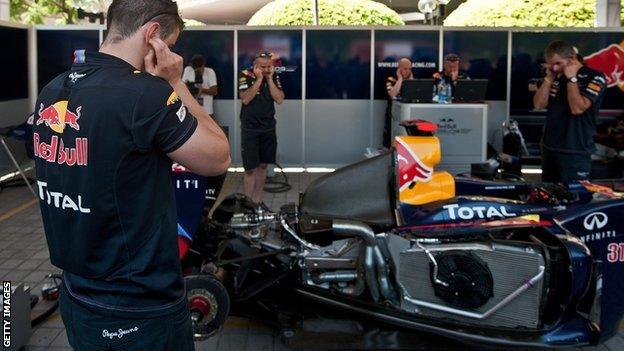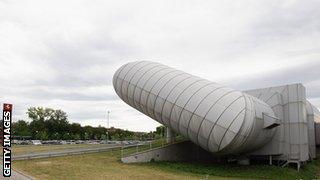How to make an F1 car - Part 3
- Published

Red Bull engineers work on their car
So far in our series about how a Formula 1 car goes from conception to race track, we have covered the basic concept and the building of the fundamental mechanical parts. This time, we'll look at performance.
In any given season, a team will know how its current car works. Or at least it should do.
Lap time is largely determined by cornering speed - the faster a car can go around corners, the faster it will be over the lap. And its cornering speed is determined by the aerodynamic behaviour of the car when it is mid-corner.
So the team will know the aerodynamic characteristics of the car with steering lock. And what they know about the current year's car and how it behaves on the track will dictate the philosophy for the next one.
You always want more downforce and less drag - that never changes. This is what F1 teams are referring to if you hear them talking about "L over D". They mean lift - or negative lift, ie downforce - compared to drag. You want your L/D figure to be as high as possible.
But you can't just take that at the expense of everything else. The car must function within that, too.
The driveability of the car is very important, and there is often a compromise between total downforce and driveability, because a higher total downforce figure can make the car more sensitive to attitude changes, and that makes it much more difficult to drive.
How the car performs transiently - as it pitches, rolls and yaws during braking, cornering and acceleration - is very important to the overall package.
So it's a constant compromise between giving the car more performance and ensuring that the driveability remains good.
The car's aerodynamic performance is heavily influenced by the way the centre of pressure - the virtual point on the car where the aerodynamic forces react, and which thus determines car behaviour - moves during braking and cornering.
It will shift backwards and forwards a bit as the driver puts more steering lock on the car. Say it moves forwards 1% with every five degrees of steering angle but the car is still lacking a bit of front-end grip; you might decide it would be better if it moved forward 1.5%. So that would be the objective the designer is working with.
It would be the same with all aspects of the car - if the way the airflow in the diffuser separates depending on ride-height has always been a little bit of a problem, for example, then you will try to make it better, and so on.
All the characteristics a team wants to improve will be written on to a specification sheet to give the aerodynamicists the parameters with which the technical director wants to move the car forward.
The spec sheet will cover everything on the car - from aerodynamic performance to the strength of the suspension and other parts. That is the basis from which the car will be designed.
Take for instance the incident Sebastian Vettel had on the first lap of the Brazilian Grand Prix. He collided with another car and yet was able to continue and clinch the world championship.
All the impacts on that suspension in that accident will have been measured by Red Bull. It would be very easy to have a suspension system that can cope with the performance of the car but that would have failed in that impact, in which case Vettel wouldn't have won the world championship.
So Red Bull have built suspension that can cope with loads beyond those in normal working conditions, and that ultimately has won them the world title.
Likewise, the incident when Nico Hulkenberg's Force India crashed into Lewis Hamilton's McLaren when the German was trying to take the lead was a pretty big impact. It broke the McLaren but not the Force India.

The wind tunnel at Ferrari's Maranello base
So McLaren might want to look at that and say, 'Yes, OK, it was an accident, but the bloke in the other car - from a team half the size of ours - carried on.'
So you have to look at that and get the compromises right, because adding strength to any component adds weight and that loses performance. It's a question of the right balance.
The people who put the spec sheet together will already have a vision of what the car is going to be like when it appears.
But achieving those goals is never easy, and if it is easy then the spec sheet was not demanding enough.
Tunnel vision
The car's aerodynamics will define the ultimate performance of the car, and when they are designing a new car, teams work to targets set on the basis of how the previous car performed.
As the season progresses, certain complaints by the drivers will come up over and over again. It might be that the front tyre does not bite enough on initial turn-in, or that there is too much understeer once there is steering lock on the car, or the rear's snappy.
The designers will be trying to establish why that could happen and what the solution might be to fix it.
Take last year's Ferrari - the rear of the car was nervous during braking at the end of a long straight because the airflow was not re-attaching to the diffuser quickly enough. They will probably be putting more emphasis into the ride-height at which the diffuser airflow re-attaches for their new car.
So teams are trying to increase the performance of the car by improving the L/D but at the same time improving those handling characteristics that restricted its performance.
It is in this compromise that the bigger teams do better than the smaller teams when they are designing the car in the wind tunnels and on computational fluid dynamics programmes (CFD) - they have more manpower to try to get those solutions sorted out.
However, putting together the correct concept is like arriving at a roundabout not knowing which exit to take.
The big teams can go down all the avenues and by doing that they will find the right solution and reach their destination. A small team is forced to pick one. If they pick the right one, they can still do the job. But if they choose the wrong one, it could cost them heavily.
What the engineers are doing when they design a car is trying out as many combinations as possible for a given part of the car to try to get the best result.
A simple component such as the turning vanes we see under the front of the chassis will have had around 50 variations before they gets signed off for production. Teams also have to take into account how that part is going to affect the behaviour of the airflow over the rest of the car.
To simulate all the different designs in CFD with the car at all the different ride heights and steering angles and understand them is very difficult. To do it in a wind tunnel is also a huge task but at least it is in a much more realistic environment.
The way the wind tunnel models are set up now you can do it in one run.
The model will go through a ride-height sequence, as well as a roll and yaw and steering sequence. That's how sophisticated the new 50% or 60% wind tunnels the teams are using have become.
The wind tunnel is just a tool used to help create a coherent aerodynamic package. It is important to keep working within the procedures that allow you to understand the components tested.
In the high intensity of battle it's very easy to just focus on the L/D figures and forget about steering lock and roll and yaw and so on because it will take less time. But if you do that, you are going to end up biting yourself in the butt pretty quickly.
Next time: designing the detailed aspects of the car and which ones are most important in determining performance
Gary Anderson was talking to BBC Sport's Andrew Benson
- Published26 December 2012
- Published21 December 2012
- Published21 December 2012
- Published21 December 2012